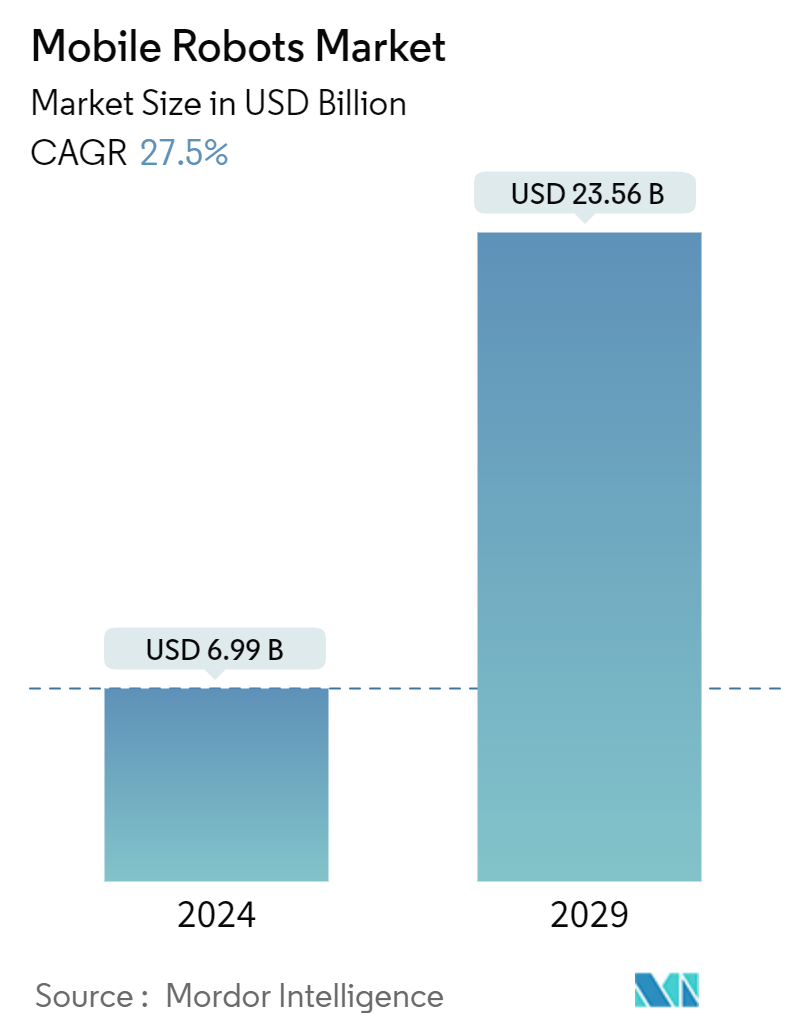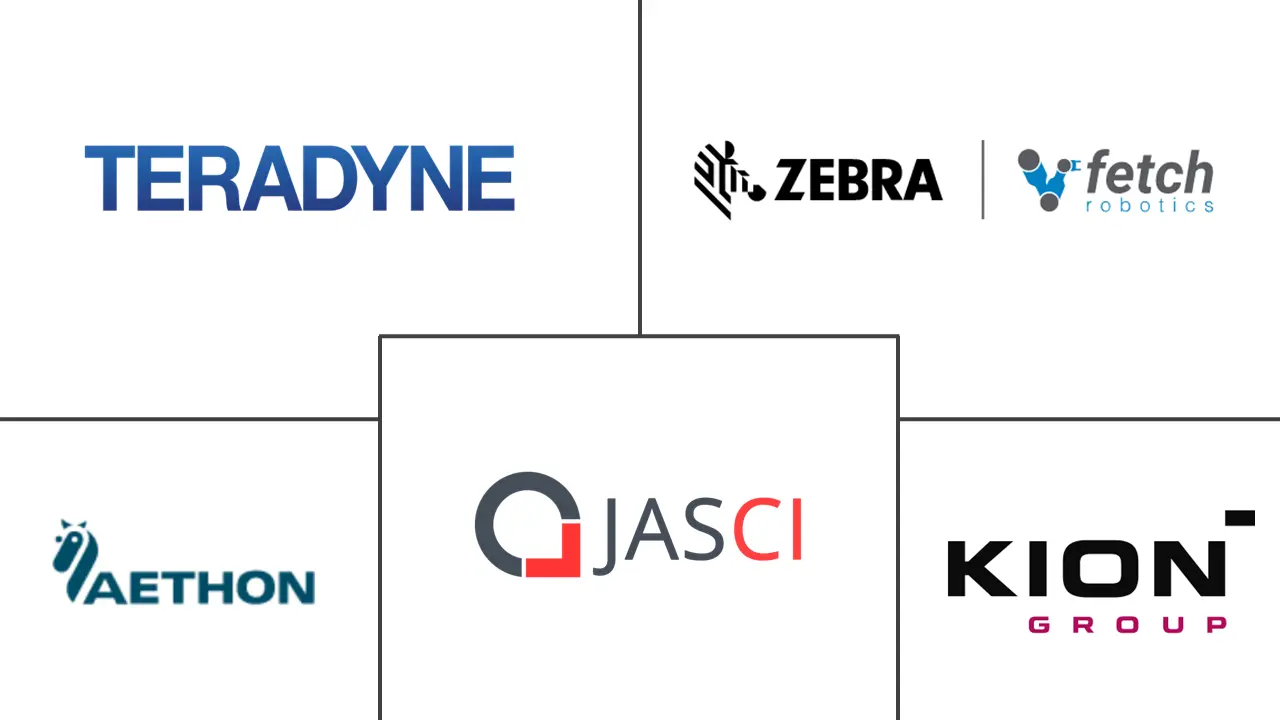Market Size of Mobile Robots Industry

| Study Period | 2019 - 2029 |
| Base Year For Estimation | 2023 |
| Market Size (2024) | USD 6.99 Billion |
| Market Size (2029) | USD 23.56 Billion |
| CAGR (2024 - 2029) | 27.50 % |
| Market Concentration | Low |
Major Players
*Disclaimer: Major Players sorted in no particular order |
Mobile Robots Market Analysis
The Mobile Robots Market size is estimated at USD 6.99 billion in 2024, and is expected to reach USD 23.56 billion by 2029, growing at a CAGR of 27.5% during the forecast period (2024-2029).
- E-commerce Growth Drives Warehouse Automation: The rapid expansion of e-commerce is transforming the mobile robots market. Global retail e-commerce sales are expected to hit USD 6.38 trillion by 2024, up from USD 4.28 trillion in 2020. This significant increase is fueling the need for warehouse automation, with mobile robots such as Autonomous Mobile Robots (AMRs) and Automated Guided Vehicles (AGVs) playing a vital role in streamlining operations. Companies like Amazon and Walmart have made substantial investments, with Amazon allocating USD 1 billion and Walmart committing USD 14 billion towards automation initiatives.
- E-commerce growth: A 43% increase in 2020, largely influenced by the global pandemic and evolving consumer habits.
- Market projections: E-commerce is forecasted to represent 31% of total sales in the US by 2026, up from its current 23%.
- Industry adoption: The consumer electronics sector leads B2C e-commerce globally, generating USD 988.4 billion in 2022.
- Deployment examples: Geodis plans to deploy 1,000 autonomous mobile robots across its global facilities over the next two years.
- Labor Costs and Workforce Challenges: Rising labor costs in developed nations are accelerating the deployment of mobile robots. A global labor shortage, driven by declining birthrates and aging populations, is pushing industries toward automation. In the US, the average salary for Industrial Truck and Tractor Operators ranges between USD 34,488 and USD 50,110 annually. The trend is reflected globally, with labor costs in the euro area increasing by 4.0% year-over-year in Q2 2022.
- Labor cost increase: The euro area saw a 4.0% rise in hourly labor costs, while the EU experienced a 4.4% increase (Q2 2022 vs. Q2 2021).
- Wage statistics: In the US, Industrial Truck and Tractor Operators earn an average wage of USD 39,210 annually.
- Automation benefits: Embracing AMRs can reduce labor costs by 30-100%.
- ROI potential: Investing in AGVs or AMRs often yields quick returns, lowering reliance on unskilled labor.
- Technological Advancements and Market Expansion: The mobile robots market is undergoing rapid technological advancements, expanding its applications across industries. Artificial Intelligence (AI) is playing a crucial role in enabling AMRs to complete complex tasks without extensive programming. The rollout of 5G technology is anticipated to open new opportunities by enhancing the deployment and management of multiple robots.
- AI integration: AI is enabling more intelligent robots capable of recognizing objects and navigating complex environments.
- 5G impact: With 5G connections expected to surpass 1 billion in 2022 and 2 billion by 2025, AMRs will benefit from improved performance.
- Market segmentation: AMRs accounted for 57.8% of the mobile robots market in 2022, with the unit load segment holding 34.8% of the form-factor market.
- Geographical trends: China led the market with a 33.2% share in 2022, while the Asia Pacific region is expected to witness the fastest growth rate at 30.5%.
- Industry Applications and Market Dynamics: Mobile robots are increasingly being used across industries, with manufacturing and logistics at the forefront. In the automotive sector, AMRs are optimizing production and improving safety. Electronics manufacturers are also leveraging mobile robots to enhance supply chain efficiency and minimize errors. The trend is moving towards more sophisticated autonomous systems, with AMRs surpassing traditional AGVs in terms of adoption.
- Manufacturing applications: The automotive industry is using AMRs for flexible material handling and to create safer work environments.
- Electronics sector: AMRs are improving internal logistics, and by 2024, a significant portion of the industry is expected to employ them.
- Market drivers: Rapid growth in e-commerce, rising labor costs, and technological innovation are driving market growth.
- Challenges: High initial costs remain a concern, although the potential for long-term ROI is significant.
Mobile Robots Industry Segmentation
Mobile robots are autonomous or semi-autonomous machines designed to move around in their environment without needing a fixed base or external guidance. They frequently have sensors, cameras, and other equipment to perceive and interact with their surroundings and are controllable via onboard computers or remote control.
The mobile robots market is segmented by product (automated guided vehicle (AGV), autonomous mobile robot (AMR)), by form factor (forklift, tow tractor, tug, unit load, assembly line), by navigation sensor (reflector, QR code, laser/liDAR, camera, hybrid (camera & LiDAR)), by the environment of operation (manufacturing (automotive, electrical & electronics, food & beverage, chemical & pharmaceuticals), non-manufacturing (logistics centers/distribution centers/warehouses), and geography (United States, China, Europe, Asia-Pacific (excluding China), and the Rest of the World). The market sizes and forecasts are provided in terms of value (USD) for all the segments.
| By Product | |
| Automated Guided Vehicle (AGV) | |
| Autonomous Mobile Robot (AMR) |
| By Form Factor | |
| Forklifts | |
| Tow/Tractor/Tug | |
| Unit Load | |
| Assembly Line |
| By Navigation Sensor | |
| Reflector | |
| QR Code | |
| Laser/LiDAR | |
| Camera, Hybrid (Camera & LiDAR) and Other navigation sensors |
| By Environment of Operation | |
| Manufacturing (Automotive, Electrical & Electronics, Food & Beverage, Chemical & Pharmaceuticals and Other Environments of Operation) | |
| Non-Manufacting (Logistics Centers/Distribution Centers/Warehouses) |
| By Geography*** | |
| United States | |
| Europe | |
| Asia | |
| China | |
| Australia and New Zealand | |
| Latin America | |
| Middle East and Africa |
Mobile Robots Market Size Summary
The mobile robots market is experiencing significant growth, driven by the increasing demand for automation across various industries. The rise of e-commerce has been a major catalyst, as companies seek efficient solutions for warehousing and inventory management to meet consumer expectations for quick delivery. Mobile robots, including autonomous mobile robots (AMRs) and automated guided vehicles (AGVs), are becoming integral to logistics and manufacturing operations, offering enhanced operational efficiencies and adaptability to changing workflows. The adoption of these technologies is further supported by trends such as lights-out automation and the need for contactless solutions in workplaces. As businesses strive to optimize their supply chains and improve productivity, the market for mobile robots is poised for substantial expansion.
In addition to the e-commerce boom, the mobile robots market is benefiting from advancements in technology and strategic investments in key regions like China. The Chinese government's initiatives, such as Made in China 2025, are propelling the development of high-tech industries, including robotics and artificial intelligence, which are central to the fourth industrial revolution. The market is becoming increasingly competitive, with numerous players entering the space and investing in research and development to innovate and enhance product offerings. Partnerships and collaborations, such as those between JASCI Software and Tompkins Robotics, are further driving advancements in warehouse automation solutions. As the market evolves, mobile robots are expected to play a crucial role in transforming industrial and commercial operations globally.
Mobile Robots Market Size - Table of Contents
-
1. MARKET INSIGHTS
-
1.1 Market Overview
-
1.2 Industry Attractiveness - Porter's Five Forces Analysis
-
1.2.1 Bargaining Power of Suppliers
-
1.2.2 Bargaining Power of Buyers/Consumers
-
1.2.3 Threat of New Entrants
-
1.2.4 Threat of Substitutes
-
1.2.5 Intensity of Competitive Rivalry
-
-
1.3 Industry Value Chain Analysis
-
1.4 Impact of Macro Trends on the Market
-
-
2. MARKET SEGMENTATION
-
2.1 By Product
-
2.1.1 Automated Guided Vehicle (AGV)
-
2.1.2 Autonomous Mobile Robot (AMR)
-
-
2.2 By Form Factor
-
2.2.1 Forklifts
-
2.2.2 Tow/Tractor/Tug
-
2.2.3 Unit Load
-
2.2.4 Assembly Line
-
-
2.3 By Navigation Sensor
-
2.3.1 Reflector
-
2.3.2 QR Code
-
2.3.3 Laser/LiDAR
-
2.3.4 Camera, Hybrid (Camera & LiDAR) and Other navigation sensors
-
-
2.4 By Environment of Operation
-
2.4.1 Manufacturing (Automotive, Electrical & Electronics, Food & Beverage, Chemical & Pharmaceuticals and Other Environments of Operation)
-
2.4.2 Non-Manufacting (Logistics Centers/Distribution Centers/Warehouses)
-
-
2.5 By Geography***
-
2.5.1 United States
-
2.5.2 Europe
-
2.5.3 Asia
-
2.5.4 China
-
2.5.5 Australia and New Zealand
-
2.5.6 Latin America
-
2.5.7 Middle East and Africa
-
-
Mobile Robots Market Size FAQs
How big is the Mobile Robots Market?
The Mobile Robots Market size is expected to reach USD 6.99 billion in 2024 and grow at a CAGR of 27.5% to reach USD 23.56 billion by 2029.
What is the current Mobile Robots Market size?
In 2024, the Mobile Robots Market size is expected to reach USD 6.99 billion.

